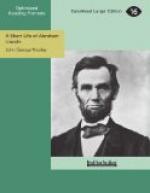But in this hope he was disappointed. During the day the vanguard of Buell’s army had arrived on the opposite bank of the river. Before nightfall one of his brigades was ferried across and deployed in front of the exultant enemy. During the night and early Monday morning three superb divisions of Buell’s army, about twenty thousand fresh, well-drilled troops, were advanced to the front under Buell’s own direction; and by three o’clock of that day the two wings of the Union army were once more in possession of all the ground that had been lost on the previous day, while the foiled and disorganized Confederates were in full retreat upon Corinth. The severity of the battle may be judged by the losses. In the Union army: killed, 1754; wounded, 8408; missing, 2885. In the Confederate army: killed, 1728; wounded, 8012; missing. 954.
Having comprehended the uncertainty of Buell’s successful junction with Grant, Halleck must have received tidings of the final victory at Pittsburg Landing with emotions of deep satisfaction. To this was now joined the further gratifying news that the enemy on that same momentous April 7 had surrendered Island No. 10, together with six or seven thousand Confederate troops, including three general officers, to the combined operations of General Pope and Flag-Officer Foote. Full particulars of these two important victories did not reach Halleck for several days. Following previous suggestions, Pope and Foote promptly moved their gunboats and troops down the river to the next Confederate stronghold, Fort Pillow, where extensive fortifications, aided by an overflow of the adjacent river banks, indicated strong resistance and considerable delay. When all the conditions became more fully known, Halleck at length adopted the resolution, to which he had been strongly leaning for some time, to take the field himself. About April 10 he proceeded from St. Louis to Pittsburg Landing, and on the fifteenth ordered Pope with his army to join




